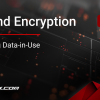Everything to know about the upcoming Digital Personal Data Protection Bill in India – part 2

In the first part of our two-part series on the upcoming Digital Personal Data Protection Bill (the Bill) in India, we elaborated on the Bill’s various mandates that organizations should keep in mind while storing and processing the personal data of their Indian customers.
In this second part, let’s look at three key technologies – Data Encryption, Centralized Key Management, and Hardware Security Modules (HSMs), that organizations can leverage to safeguard their customers’ personal data and cohesively adhere to the Bill’s data protection guidelines. Let’s begin…
Data encryption
As we are all aware, data encryption is a crucial defense against cyberattacks and data breaches.
By converting plaintext data into illegible ciphertext that can only be deciphered with the corresponding decryption key, data encryption has the potential to prevent threat actors from causing significant damage through various malware attacks, including ransomware, man-in-the-middle (MITM), and DDoS attacks.
When implementing a data encryption strategy, organizations should consider the following factors:
Choosing the right algorithm
Selecting the appropriate encryption algorithm is a key aspect of any data encryption strategy. The most commonly used algorithms globally are the Advanced Encryption Standard (AES) and Rivest-Shamir-Adleman (RSA).
AES, based on symmetric encryption, uses a single shared key for both encryption and decryption. It offers fast performance and is capable of securing large volumes of data with key sizes ranging from 128 bits to 256 bits.
RSA, based on asymmetric encryption, employs separate public and private keys for encryption and decryption. This approach enhances data security by establishing a secure communication channel between senders and receivers.
When choosing an encryption algorithm, consider factors such as the type of data to be encrypted, the performance requirements of your IT systems, and any regulatory mandates specific to your industry.
Encrypting both data-at-rest and data-in-transit
A robust data protection strategy should encompass encryption for both data-at-rest (stored data) and data-in-transit (transmitted data).
To ensure cohesive protection of data-at-rest, organizations should first identify where their sensitive data resides and then encrypt it with the right encryption algorithm. Finally, organizations should implement strong identity and access controls to ensure that only authorized personnel and systems have access to this data.
To secure data-in-transit, organizations should use secure communication protocols such as SSL/TLS or HTTPS to encrypt the transmitted data. These protocols cohesively secure the end-to-end connection between the data sender and the receiver, and seamlessly protect the data from interception or tampering during transmission.
By considering these factors and implementing a comprehensive data encryption strategy, organizations can strengthen their defenses against cyber threats and protect sensitive information
Encryption key management
A common misconception is that simply encrypting data is enough to protect it. However, the truth is that protecting encryption keys is equally critical. Encryption keys go through multiple stages during their lifecycle, such as creation, distribution, storage, rotation, and backup. Safeguarding them at every stage is paramount.
To ensure secure key management, organizations should implement a robust Centralized Key Management solution. Here are two key benefits of such a solution:
Consistent key security
A centralized key management platform enforces uniform security policies across the organization. This ensures that all encryption keys adhere to the same security standards, making it easier to meet regulatory compliance requirements and mitigate the risk of data breaches. By maintaining consistent key security, organizations can ensure the confidentiality and integrity of their encrypted data.
Simplified key lifecycle management
Centralized key management systems streamline the end-to-end key management process by providing a single, unified interface for managing all encryption keys across diverse locations. This simplifies the key management exercise, reducing complexity and the risk of human errors. It allows organizations to efficiently handle key generation, distribution, rotation, revocation, and backup, ensuring smooth operations while maintaining the highest level of security.
By implementing a centralized key management solution, organizations can effectively protect their encryption keys, which are vital for securing sensitive data. It not only strengthens data protection but also facilitates compliance with industry regulations and standards.
Hardware security modules (HSMs)
To ensure the security of encryption keys and prevent the encryption exercise from being rendered futile, organizations should deploy advanced Hardware Security Modules (HSMs) to protect their keys. HSMs are specialized physical devices designed to securely store and manage encryption keys.
When deploying HSMs, organizations should consider the following:
The intended use cases
HSMs come in various types, such as General Purpose HSMs and Payment HSMs, and the choice depends on the specific use case.
General Purpose HSMs can be used for a wide range of activities, including encrypting data-at-rest and data-in-transit, generating and authenticating digital signatures, and key generation, storage, and management for various cryptographic operations.
Payment HSMs, on the other hand, are specifically designed to secure financial transactions and payment processing systems. They have specialized features tailored to meet the stringent requirements of the BFSI industry. Payment HSMs are primarily used for securing credit/debit card PINs, generating, storing, and managing cardholder data, key management for Point-to-Point Encryption (P2PE), and cryptographic processing during data tokenization.
Integration with existing encryption infrastructure
For cohesive data protection, organizations should integrate HSMs with their existing encryption and key management ecosystem.
When selecting an HSM, it is pivotal to check its compatibility with the organization’s existing encryption setup. This includes meticulously checking for the supported encryption algorithms, protocols, and APIs.
Additionally, organizations should choose an HSM that supports their scalability plans, with the capacity to handle anticipated cryptographic loads. Advanced features like clustering, load balancing, and disaster recovery should also be considered to ensure seamless business continuity.
By carefully considering the use cases and integrating HSMs with existing encryption infrastructure, organizations can enhance the security of their encryption keys and strengthen their overall data protection measures.
Summing up
With India rapidly moving towards implementing the Digital Personal Data Protection Bill, organizations should gear up and start evaluating data protection solution providers to protect their customers’ personal data.
As one of the global leaders in enterprise data protection, over the last 40 years Futurex has helped hundreds of leading organizations seamlessly protect their sensitive data and comply with all data protection mandates.
Futurex’s encryption solutions offer end-to-end protection for data-at-rest and data-in-transit to ensure that your organization’s sensitive data stays secure no matter where it is stored or transmitted.
Furthermore, to efficiently manage and secure the encryption keys at every juncture of their lifecycle, Futurex offers an advanced series of Key Management Enterprise Servers (KMES) that are widely recognized as one of the most versatile key management solutions in the market today.
These state-of-the-art centralized key management systems can be deployed as comprehensive, all-in-one cryptographic modules, or leveraged for individual cryptographic operations through the centralized VirtuCrypt cloud, and even seamlessly integrated with your existing critical infrastructure.
Lastly, Futurex offers a diverse range of FIPS 140-2 Level 3 and PCI-validated General Purpose and Payment HSMs that can be seamlessly deployed on-premises, in the cloud, or as a scalable hybrid model. With vendor-neutral APIs, Futurex’s HSMs offer seamless flexibility and easy integration to help you protect sensitive data like never before.
To learn how Futurex can help you secure your customers’ personal data and adhere to the upcoming Digital Personal Data Protection Bill, please visit https://www.futurex.com or get in touch with our experts at sales@futurex.com.
FAQ
How does the Digital Personal Data Protection Bill in India influence organizations’ approaches to data encryption and protection?
The Digital Personal Data Protection Bill in India reshapes organizations’ data encryption and protection strategies by enforcing strict guidelines to safeguard customers’ personal data. Mandating robust encryption measures for data-at-rest and data-in-transit, the bill emphasizes strong encryption algorithms and secure protocols, while also stressing centralized encryption key management solutions and hardware security modules (HSMs) for key protection. Overall, organizations must enhance their data security practices to comply with regulations and protect individuals’ privacy rights in the digital age.
What are the key considerations organizations should keep in mind when selecting encryption algorithms for their data protection strategies?
When selecting encryption algorithms, organizations must consider factors such as data sensitivity, performance needs, and industry regulations. This ensures tailored data protection strategies that meet both security and compliance requirements. Additionally, understanding the specific requirements and constraints of their IT systems is crucial for organizations to choose encryption algorithms that seamlessly integrate with their existing infrastructure. By carefully evaluating these factors, organizations can implement encryption strategies that effectively balance security, performance, and compliance concerns.
How do HSMs enhance encryption key security, and what should organizations consider when deploying them with existing encryption setups?
Hardware Security Modules (HSMs) enhance encryption key security by securely storing and managing keys, protecting them from unauthorized access. When deploying HSMs with existing encryption setups, organizations must ensure compatibility, scalability, and regulatory compliance. By addressing these factors, organizations can effectively leverage HSMs to bolster data protection measures.






